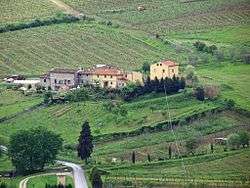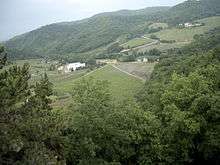Chianti
Chianti is an area of Tuscany, Italy made famous by the red wine of the same name. It has much to offer for a visitor interested in wine, food and natural beauty. Many of the wineries are open for a tour and a tasting, and some offer accommodation services as well.
Cities

- 🌍 Florence
- 🌍 Siena
- 🌍 Greve (Greve in Chianti)
- 🌍 Reggello
- 🌍 San Casciano in Val di Pesa
- 🌍 Tavarnelle Val di Pesa
- 🌍 Radda
- 🌍 Castellina
- Gaiole
- 🌍 Panzano
- Castelnuovo Berardenga
- 🌍 Montemarciano
Understand

Chianti is above all a wine zone. It is not an administrative region and includes parts of the Tuscan provinces of Florence, Siena, Arezzo and Pisa. The Chianti DOCG appellation is divided into seven subregions (Classico, Colli Aretini, Colli Fiorentini, Colline Pisane, Colli Senesi, Montalbano and Rufina), of which Classico is the most famous.
The Chianti Classico region in turn is defined by the towns between Florence and Siena: Greve, Panzano, Castellina, Gaiole and Radda. Almost all the famous Chianti estates are located near one of these towns, although Rufina is to the east of Florence.
In addition to the red wine, many producers make the dessert wine Vin Santo del Chianti as well as "Super Tuscan" wines that do not adhere to the DOC regulations. Some also make olive oil.
Get in
From abroad, usually the best way to reach Chianti is to fly to an airport in Tuscany, such as the Pisa or Florence airport, or some other major airport in Italy. Alternatively, from Central Europe one might want to take a train to Italy. Once in Italy and preferably in Tuscany, you have to find your way to Florence; this will be easy as the city has good train connections to the rest of the country. From Florence there are several alternatives to get to Chianti: rental car, bus, taxi, etc.
Precise instructions are difficult to give since it depends so much on from where you are departing and exactly where you will be staying (in Florence, in Siena, in Greve, or some other place in the region).
Get around
Chianti is easiest to explore with a car. The most likely place to begin the trip is Florence, where rental services are abundant. The most important road to know is the Chiantigiana from Florence to Siena, as it penetrates the heart of the region, Chianti Classico.
Without car, the region is accessible with SITA buses from Florence. The hills of Chianti are a magnificent place for bike tours. Cycling you can enjoy at best the beautiful landscape of this region. You will rarely be cycling in flat roads, but you will also seldom have to climb steep passes (only, be ware of the hot hours of the day in the Summer). You can start from Greve, for example, where you can rent a bike.
See
For someone interested in museums, churches and such things it is not necessary to leave Florence or Siena. However, the Chianti area can be an excellent base from which to explore Tuscany as whole without having to stay in these crowded cities. The countryside is beautiful, and absolute gems that should be visited are the hamlets of Montefioralle and Volpaia, and the beautiful towns of Greve, Panzano, Radda and Castellina.
Do

The region is an invaluable treasure for those who are interested in exploring the eno-gastronomic culture of Tuscany.
See also: Wine tourism#Italy
With serious competition only from a few neighboring regions in Tuscany and from Piedmont, Chianti is one of Italy's prime wine regions. The best way to tour the wineries and sample their products is on the last Sunday of May when many producers throughout Italy open their doors for the festival of Cantine Aperte. Tastings are free and reservations unnecessary, so if you like wine and happen to be in Tuscany at the time, this is a fantastic opportunity for you. You should however keep in mind that not all the wine produced in Chianti is exceptional and that some of the best producers do not even participate in Cantine Aperte, so it makes sense to plan ahead and be choosy.
Olive groves are also the region's pride, and while it is not normally possible to visit an oil press, olive oil can be purchased directly from the producers. Olives are pressed in November and December and the olio nuovo or new oil, which is very piquant for the first several months, is especially prized on bruschetta and ribollita.
Eat
Food in the region is very commonly made with Chianti, in cases of wine sauces, and is in any case well paired with a glass of Chianti. You may want to choose more robust Chiantis with food like cinghiale (wild boar) or bistecca alla fiorentina (Florentine-style charred steak) than with pasta, but it's quite common to have a quartino or share a bottle of the house Chianti with an entire meal in trattorie in the region. Of course, if you are a lusty drinker or with a larger group, you can more easily choose one bottle with the primi piatti (pasta or soup) and another with the secondi piatti (usually fowl or red meat in this region).
If you have access to your own cooking facilities, you may want to follow the cook's adage that food tastes better when you use a good wine in your sauces, and then drinking some of that same wine with the meal brings out the flavours of both the food and the wine better.
Drink
If you want to go to Chianti, the natural assumption is that you want to drink the wine. It is made with the sangiovese grape, although lesser quantities of other grape varieties may be added. There are different philosophies of making Chianti: some prefer traditional blends with sangiovese and other local grapes (including white ones), some use international varieties such as merlot, and finally there are those who use only sangiovese for their Chianti.
The taste of the wine depends a lot on the producer's decisions, but also on the exact place where the vines are grown. Sangiovese is known as a rather difficult grape to grow, and differences in the land affect the taste of the resulting wine. Traditionally Chianti is a light wine with high acidity with a slightly bitter but fruity taste and berry aromas. As international markets demand high-fruit, high-alcohol wines, Chianti is changing as well, and more modern versions have a fuller, although less recognizable taste.
Sleep
There are lots of lovely hill-top towns in Chianti with plenty of good hotels and B&Bs. However, if you want to get away from the traffic and noise, then this is your chance to stay in one of dozens of 'agriturismi' in the area, working farms that also rent out apartments or rooms to travellers who would like to experience at close hand the Chianti countryside. It makes good sense to pick a central location and to use this as a base for your trips to Florence and Siena, as well as your trips to the beautiful towns and villages, like Castellina in Chianti, San Gimignano, Panzano, Radda, and so on.